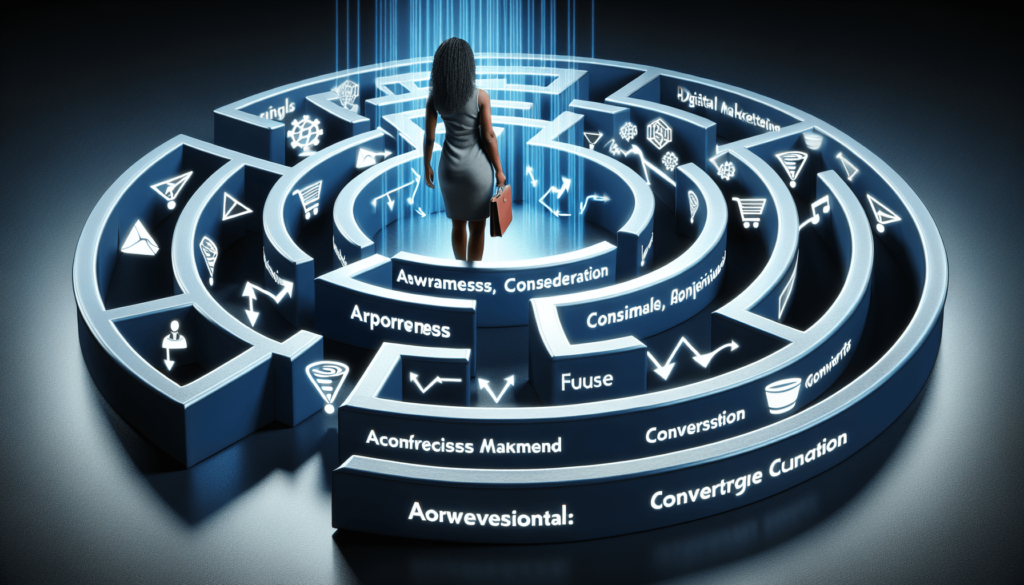You’re about to embark on an exciting journey to learn how to develop a digital marketing funnel. In today’s fast-paced and competitive business world, having a well-defined digital marketing funnel is essential for success. This article will guide you through the key steps to create an effective funnel that will attract, engage, and convert your target audience into loyal customers. With a friendly tone and practical advice, you’ll gain the knowledge and confidence needed to take your digital marketing efforts to the next level. Let’s dive in and discover the secrets of developing a winning digital marketing funnel!

Understanding the Digital Marketing Funnel
A digital marketing funnel is a framework that maps out the customer’s journey from the point of initial awareness to the point of conversion and beyond. It helps businesses visualize and understand the different stages of the customer’s journey and allows them to tailor their marketing strategies accordingly.
Definition of a Digital Marketing Funnel
In simple terms, a digital marketing funnel is a series of steps that a potential customer goes through before making a purchase or engaging with a brand. It is often represented as a funnel shape because it illustrates the gradual narrowing down of potential customers at each stage.
Importance of a Digital Marketing Funnel
Having a well-defined digital marketing funnel is crucial for any business looking to succeed in the online space. It provides a structured approach to lead generation, nurturing, and conversion, ultimately leading to increased sales and customer loyalty. By understanding the different stages of the funnel, businesses can create targeted and personalized marketing strategies at each step, maximizing their chances of success.
Components of a Digital Marketing Funnel
A digital marketing funnel typically consists of several core components. The main stages include:
- Awareness: This is the stage where potential customers become aware of a brand’s existence or a particular problem they may have.
- Interest: At this stage, potential customers start showing interest in a brand’s products, services, or solutions.
- Consideration: Here, potential customers consider different options and evaluate whether a particular brand can meet their needs.
- Conversion: This is the stage where potential customers make a purchase or take the desired action, becoming a paying customer.
- Loyalty: After the initial conversion, businesses strive to foster customer loyalty and encourage repeat purchases or engagement.
Each stage of the funnel requires specific marketing strategies and tactics to effectively guide potential customers through the journey.
Identifying Your Target Audience
Before diving into creating a digital marketing funnel, it is essential to identify and understand your target audience. This step ensures that your marketing efforts are focused on the right people who are most likely to convert into customers.
Market Research
Market research is the foundation of understanding your target audience. It involves gathering and analyzing data about your industry, competitors, and potential customers. By conducting market research, you can gain insights into customer preferences, pain points, and buying behavior.
Creating Buyer Personas
Buyer personas are fictional, generalized representations of your ideal customers. They are created based on market research data and help businesses better understand their target audience’s demographics, interests, motivations, and challenges. Developing buyer personas allows you to tailor your marketing messages and strategies to resonate with the specific needs of different customer segments.
Understanding Customer Journey
The customer journey refers to the process that a potential customer goes through before making a purchase. It typically includes various touchpoints and interactions with a brand, both online and offline. By understanding the customer journey, businesses can identify the key moments when they can engage with potential customers and provide relevant information or assistance.
Setting Clear Marketing Goals
To effectively develop a digital marketing funnel, it is crucial to set clear marketing goals that align with your overall business objectives.
Defining Objectives
Start by defining your marketing objectives, such as increasing brand awareness, generating leads, or driving product sales. Make sure your goals are specific, measurable, achievable, relevant, and time-bound (SMART). This will provide a clear direction for your marketing efforts and help you track progress towards your objectives.
Key Performance Indicators (KPIs)
Once you have defined your objectives, identify the key performance indicators (KPIs) that will measure your progress towards those goals. KPIs can include metrics such as website traffic, conversion rates, email open rates, or social media engagement. Regularly monitoring and analyzing these KPIs will help you gauge the effectiveness of your marketing strategies and make data-driven decisions.
Creating Awareness
The first stage of the digital marketing funnel is creating awareness about your brand, products, or services. Here are some effective strategies to generate awareness:
Content Marketing
Content marketing involves creating and sharing relevant, valuable, and engaging content to attract and educate your target audience. This can include blog posts, videos, infographics, and social media posts. By providing valuable information, insights, or solutions to your audience’s problems, you can establish your brand as a trusted authority and increase awareness.
Search Engine Optimization (SEO)
SEO is the practice of optimizing your website and content to rank higher in search engine results pages (SERPs). By optimizing your website for relevant keywords and improving its overall visibility, you can drive organic traffic and increase brand exposure.
Social Media Marketing
Social media platforms provide a powerful channel to reach and engage with your target audience. By creating compelling social media content, running targeted ads, and actively interacting with your followers, you can generate awareness and build a community around your brand.

Generating Interest
Once potential customers are aware of your brand, it’s time to generate interest and capture their attention. Here are some effective strategies to generate interest:
Email Marketing
Email marketing allows you to directly communicate with your leads and nurture them through personalized and targeted emails. By offering valuable content, exclusive offers, or personalized recommendations, you can keep your brand top of mind and encourage further interaction.
Paid Advertising
Paid advertising, such as Google Ads or social media ads, can help you reach a wider audience and target specific demographics or interests. By creating compelling ad campaigns that highlight the benefits of your products or services, you can generate interest and drive relevant traffic to your website.
Influencer Marketing
Influencer marketing involves collaborating with industry influencers or popular personalities to promote your brand or products. By leveraging their credibility and large following, you can tap into existing communities and generate interest among their audience.
Encouraging Consideration
At the consideration stage, potential customers are actively evaluating different options and deciding whether your brand is the right fit for their needs. Here are some effective strategies to encourage consideration:
Lead Nurturing
Lead nurturing involves building relationships with potential customers and guiding them through their decision-making process. By providing personalized and relevant content, addressing their concerns, and offering additional information or resources, you can further educate and convince them to choose your brand.
Remarketing
Remarketing allows you to target ads specifically to people who have previously interacted with your website or shown interest in your products or services. By showing relevant ads to these potential customers, you can stay top of mind and encourage them to consider your brand during their decision-making process.
Customer Testimonials
Customer testimonials and reviews play a crucial role in building trust and credibility. Sharing positive reviews or testimonials from satisfied customers can help potential customers feel more confident in choosing your brand over competitors.
Driving Conversion
The conversion stage is where potential customers take the desired action, such as making a purchase or submitting a contact form. Here are some effective strategies to drive conversion:
Landing Pages
Landing pages are dedicated webpages designed to prompt a specific action from visitors, such as filling out a form or making a purchase. By optimizing your landing pages for conversion, reducing friction, and clearly communicating the value proposition, you can increase the likelihood of conversion.
Call-to-Action (CTA)
A call-to-action (CTA) is a clear and compelling message that prompts potential customers to take a desired action. By strategically placing CTAs throughout your website, emails, or ads, you can guide visitors towards conversion and make it easy for them to take the next step.
A/B Testing
A/B testing involves creating two different versions of a webpage, email, or ad and testing them against each other to determine which performs better. By continuously optimizing your marketing assets through A/B testing, you can identify what resonates best with your target audience and improve conversion rates.
Fostering Customer Loyalty
After successfully converting potential customers, it is important to foster customer loyalty and encourage repeat purchases or engagements. Here are some effective strategies to foster customer loyalty:
Email Campaigns
Email campaigns targeted at existing customers can help foster long-term relationships and encourage repeat purchases. By offering exclusive discounts, personalized recommendations, or valuable content, you can keep your brand top of mind and show appreciation for their continued support.
Upselling and Cross-Selling
Upselling involves encouraging customers to upgrade or purchase additional products or services, while cross-selling involves recommending complementary or related products or services. By strategically implementing upselling and cross-selling techniques, you can increase the average order value and deepen customer loyalty.
Customer Support
Providing excellent customer support is crucial for building strong relationships and retaining customers. By promptly addressing customer inquiries or concerns, offering technical assistance, and actively seeking feedback, you can show your commitment to customer satisfaction and foster loyalty.
Analyzing and Improving the Funnel
Regularly analyzing and improving the digital marketing funnel is essential for achieving optimal results. Here are some strategies to analyze and improve your funnel:
Analytics and Data Tracking
Utilize analytics tools, such as Google Analytics, to track and measure the performance of your marketing efforts. By analyzing data on website traffic, conversion rates, and customer behavior, you can identify areas for improvement and make data-driven decisions.
Conversion Rate Optimization
Conversion rate optimization (CRO) focuses on improving the percentage of website visitors who take the desired action. By testing and optimizing different elements, such as headlines, images, or CTAs, you can increase the likelihood of conversion and improve overall funnel performance.
Continuous Testing and Iteration
Digital marketing is an iterative process. Continuously test and refine your strategies, messages, and tactics based on data and customer feedback. By remaining agile and adapting to market trends or changing customer preferences, you can continuously improve the effectiveness of your marketing funnel.
Automation and Marketing Tools
Automation and marketing tools can significantly streamline and enhance your digital marketing efforts. Here are some key tools to consider:
Marketing Automation Platforms
Marketing automation platforms, such as HubSpot or Marketo, allow you to automate repetitive marketing tasks, such as email campaigns, lead nurturing, or social media scheduling. By automating these processes, you can save time and resources while maintaining personalized communication with your audience.
CRM Systems
Customer relationship management (CRM) systems, like Salesforce or Zoho CRM, help businesses manage and analyze customer data. By storing customer information, tracking interactions, and analyzing customer behavior, you can improve customer relationships and make more informed marketing decisions.
Email Marketing Software
Email marketing software, such as Mailchimp or Constant Contact, provides robust features for creating, sending, and tracking email campaigns. With pre-designed templates, segmentation options, and analytics, you can effectively engage with your audience and drive conversions through email marketing.
In conclusion, understanding and developing a digital marketing funnel is key to succeeding in the online space. By identifying your target audience, setting clear goals, and implementing effective strategies at each stage of the funnel, you can attract, engage, and convert potential customers, while fostering long-term loyalty and continuously improving your marketing efforts. By leveraging automation and marketing tools, you can streamline your processes, optimize customer relationships, and drive measurable results. Remember to regularly analyze and adapt your funnel based on data and customer feedback to stay relevant and impactful in the ever-evolving digital landscape.

